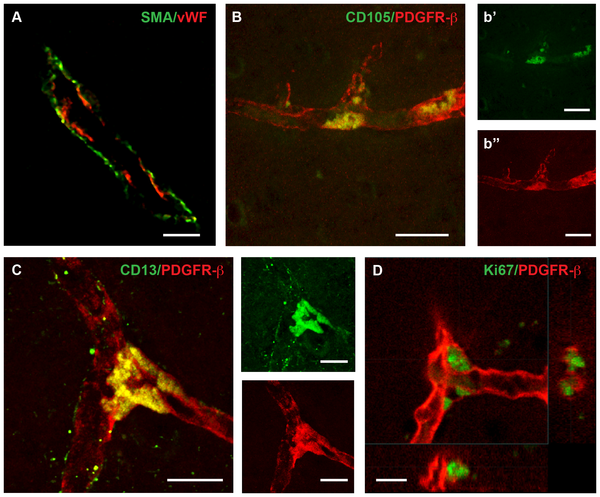New stem cell type found in the brain
April 23, 2012

The adult human brain contains perivascular cells co-expressing mesenchymal stem cell and pericyte markers (credit: Gesine Paul et al./PLoS ONE)
Researchers at Lund University in Sweden have discovered a new stem cell in the adult brain.
These cells can proliferate and form several different cell types — most importantly, new brain cells. Scientists hope to take advantage of the finding to develop methods to heal and repair disease and injury in the brain.
Analyzing brain tissue from biopsies, the researchers for the first time found stem cells located around small blood vessels in the brain. The cell’s specific function is still unclear, but its plastic properties suggest great potential.
“A similar cell type has been identified in several other organs where it can promote regeneration of muscle, bone, cartilage and adipose tissue,” said Patrik Brundin, M.D., Ph.D., Jay Van Andel Endowed Chair in Parkinson’s Research at Van Andel Research Institute (VARI), Head of the Neuronal Survival Unit at Lund University and senior author of the study.
Scientists suggest that the curative properties of these cells may also apply to the brain. The next step is to try to control and enhance stem cell self-healing properties with the aim of carrying out targeted therapies to a specific area of the brain.
“Our findings show that the cell capacity is much larger than we originally thought, and that these cells are very versatile,” said Gesine Paul-Visse, Ph.D., Associate Professor of Neuroscience at Lund University and the study’s primary author.
“Most interesting is their ability to form neuronal cells, but they can also be developed for other cell types. The results contribute to better understanding of how brain cell plasticity works and opens up new opportunities to exploit these very features.”
The study is of interest to a broad spectrum of brain research. Future possible therapeutic targets range from neurodegenerative diseases to stroke.
“We hope that our findings may lead to a new and better understanding of the brain’s own repair mechanisms,” said Dr. Paul-Visse. “Ultimately the goal is to strengthen these mechanisms and develop new treatments that can repair the diseased brain.”
Ref.: Gesine Paul et al., The Adult Human Brain Harbors Multipotent Perivascular Mesenchymal Stem Cells, PLoS ONE, 2012, DOI: 10.1371/journal.pone.0035577 (open access)